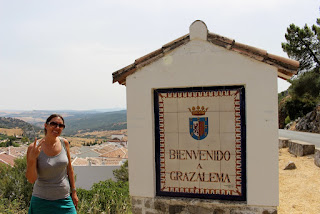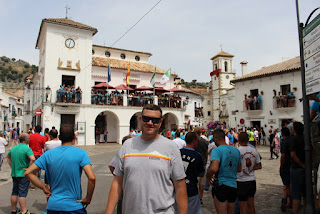Before leaving Arcos we wanted to see inside both of the town's churches (which close early and are not open at all on Sunday), and open even later than listed because they have to turn on the lights inside first (obviously).
Eric's suspicions proved to be true...
They in fact did have giants in Spain hundreds of years ago.
By 11:00 we were on our way through the fault-shaped mountains, heading for Grazalema, which seemed like a good stopping point on our way to Ronda.
We were surprised that there was a cop directing traffic, instructing people where to park.
And then even more surprised to hear people shouting in unison periodically, so curious as to what was going on in this tiny, supposedly quiet, white village.
Much to our surprise, we stumbled upon Grazalema's yearly tradition, the release of a bull into the streets, to celebrate the Virgen del Carmen.
We sought refuge inside of a plaza, so we could watch the guido-esque Spaniards taunt and then out run the bull. Cheers erupted when it was done with good form.
A cannon was eventually fired which meant that everyone got a break, they would start back up around 18:30.
One couple we met in the plaza drove over 6 hours to witness this event.
What timing we have!
The bars that we originally thought prevented cars from getting into the city, were really bull bars. They look so different from the bull bars that we have back home...
I am glad that we didn't just walk through when we first arrived, as we considered doing, although it would have been nice to show the Spaniards some of our moves, it would have been the surprise of a lifetime.
Just an hour later we were in Ronda, one of the largest white hill towns.
Trying sherry (for which the area in famous for) and some mediocre tapas (I miss the food in Córdoba!).
Ronda is most famous for the Puente nuevo (the new bridge), built in the late 1400s.
It spans the ravine, El tajo, 360 feet down and 200 feet across.
A secret mine was built inside the Arab fortress, for slaves to haul up water from a well near the river bottom. I am sure that the slaves would be interested to know that people now pay money to go down into the mine (very little is free in this country, including churches!).
The Arab Baths, just outside the city walls, are even better preserved than the ones in Córdoba.
Water used to be brought up from the river by a horse walking in circles at the top of a tower, pulling buckets up one by one to be poured into the miniature aqueduct before being heated for bathing and purifying.
As if we didn't see or walk enough today, we took the steep, dirt path down from Plaza de María Auxiliadora for the best view of 'new bridge'. It is the reason that we are here after all.
The helado was well deserved, and very much appreciated.








































Oh man, I love your timing with the Bull. How great and what photos. When I was a kid (7 or so) my big brother was stationed in Spain, so we got to experience it but your blog is so much more thorough and helpful for jolting dusty memories.
ReplyDeleteThanks for the great photos. The flowers are breathtaking.
Looks so dang fun, all of it. Jealous me in Alaska.